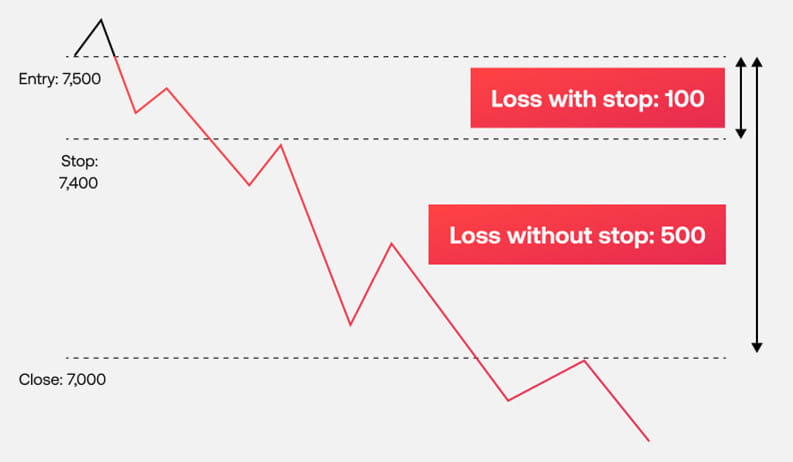What is index trading?
Index trading is the act of speculating on the price movement of a stock index – a number of stocks that, combined, make up one single market.
Different weightings are applied to some indices that mean certain stocks, such as those with a greater market capitalisation, contribute more to the index’s overall price. Price moves from the top stocks on the index consequently impact its price more than price movement from that index’s lesser-valued stocks.
To find out more, visit our ‘What are indices?’ page.
How to trade indices
Let’s run through the four steps you’ll need to follow to start trading indices: choosing a market, going long or short, managing risk and opening a position. You can follow along with these steps using a free City Index demo account – or if you’re ready for real trading, open a live account.
1. Choosing your market
Most economies have at least one corresponding index, so there are plenty of markets to choose from. With City Index, you can trade all the major global indices from around the world.
You might want to start out with a market that you’re more familiar with, or at least have access to more information about. For instance, the DAX is the main German index and is a popular market to trade, but if you live in Singapore you will get far more exposure to Asian and US market news – so you could focus on indices such as the Singapore Index, China A50 or Dow Jones instead.
Once you become more comfortable, you can then branch out and start trading other indices.
Ways to trade indices
There are also different ways to trade the same index:
- CFDs – Index CFD (contracts for difference) trading means you're speculating on the price movement of your chosen index
- ETFs – ETFs (exchange traded funds) are funds that track an established index, usually using multiple underlying assets. For instance, a FTSE ETF might invest in every FTSE 100 company to mirror the performance of the index itself. ETFs are traded on exchanges, just like shares
- Knockout Options – These options trades have a unique feature whereby the price moves one-for-one with the underlying City Index price, and provide access to higher leverage and a guaranteed closeout price. You can trade a selection of major indices as Knockout Options with City Index
Visit our indices trading page to find out more about how you can trade these markets.
2. Choose to go long or short
Next up is choosing whether to buy or sell. Buying an index will open a long position. If the price then rises, you’ll make a profit. If it falls, you’ll incur a loss. Selling an index means opening a short position. Here, you’re hoping the index’s price falls. You can then buy the index at a cheaper price to close the position out and you’ll make a profit. If the index’s price rises, you’ll lose out.

The advantage of being able to go long or short is that you can take advantage of both bullish and bearish periods.
3. Set your stop-loss and limit orders
Stop and limit orders are optional features that you can utilise, and can play a key role in trading indices successfully. Let’s examine the basics of orders to understand how they can be applied to your trades.
What are orders in trading?
Orders in trading enable you to open and close trades automatically. With stops, you can tell your provider to open or close a position when it reaches a level that is less favourable than its current price. With limits, you’re trading at a better level than the current price
Both are key to risk management. Here’s how to set them.
Setting stop-loss orders
So, with an indices trade on the FTSE 100, you might be worried about incurring steep losses if the market suddenly turns against your buy position. If we assume the price of the FTSE 100 is 7,500, you might set your stop-loss order at 7,400. This way, if its price falls to 7,400, your position will be automatically closed. You will lose money, but if the FTSE 100 continues to fall to 7,000, you’d have closed out your trade and avoided incurring an even greater loss.
If you’d shorted the FTSE 100 instead, you could place a stop at 7,600. Then, if the FTSE 100 climbs instead of falling, your position will be closed automatically once your stop level is reached.

For added protection, City Index also offer guaranteed stop loss orders (GSLOs), which are similar to standard stop-loss orders but with a guaranteed closeout price at the level you choose, regardless of market gapping and slippage. GSLOs are particularly useful during times of heightened market volatility, when gapping can result in standard stop-loss orders incurring slippage. GLSOs are free to place on thousands of markets, and you will only pay a small premium in the event that your GSLO is triggered.
With large daily swings not uncommon with certain indices, it’s worth considering where you want to set your stop-loss order before you place your trade. You can find out more about the various stop-loss orders and other risk management tools we offer.
Setting limit orders
On the other hand, limit orders (also known as take-profit orders) close out positions at a pre-determined level to secure profit. For instance, if you open a trade on the FTSE at 7,000 you might set a limit order at 7,300. This means once the price reaches that level, your trade will automatically be closed out and your profit will be secured.
4. Open and monitor your positions
Once you’ve decided to go long or short and set your stop-loss and limit orders for your indices trade, you then need to open the position. Opening the position is simple and can be done from within the trading platform.
All you need to do is select the market you want to trade by finding it in the search bar. Then click ‘Buy’ or ‘Sell’ depending on which direction you want to trade, add any stops or limits and choose the quantity you want to trade. Finally, click ‘Place Trade’ and your position is opened.
Now your position is open, you’ll need to monitor it.
How to monitor your positions
Given the unpredictability of the markets and the fact that prices can move at any time, monitoring your open positions can make a huge difference to your bottom line.
There are tools you can use to make monitoring the markets easier. You can set price alerts on your trades to receive a direct SMS message anytime there is significant price movement on your market. This allows you to act on volatility as it happens.
It’s also worth following news around the stocks on your index. This is easier when the index is based around one industry, but for the most part, an index will just be comprised of the largest stocks in the economy. Therefore, it might be worth choosing a selection of the index’s most influential stocks and tracking any news around them instead.
Another way to monitor your positions is to stay up to date with the latest company reports.
Earnings season is a period of the year where public companies release reports on their earnings for the previous quarter or year. These can be key factors in dictating a stock’s price and, with sometimes hundreds of stocks reporting each day, can often play out on an index’s price.
What moves an index?
Monitoring your positions and knowing how to combat volatility is important, but it’s also key to know what actually moves an index’s price.
Economic indicators
Indices are often seen as indicators of economic performance. Therefore, when an economy is performing well, it’s likely the corresponding index is going to do well too.
To evaluate how an economy is performing, you’ll want to look at economic indicators.
Interest rate decisions are one such example. These have a huge impact on the economic behaviour of consumers and businesses. If interest rates are lower, consumers have less incentive to save money and overall spending will likely rise. If it does, the economy usually benefits and your index’s price might see positive movement.
On the other hand, high rates suppress spending and can see indices fall.
Company earnings
As mentioned previously, company earnings are another major price factor for indices. Within a one-month period, you’ll likely see all of your index’s constituents report their earnings. One stock seeing its price change off the back of weak or strong earnings won’t cause too much fluctuation for the index, but when all stocks are reporting in a short period, volatility can hit.
If prices all move in a similar direction, you’ll then see a bullish or bearish movement with your index.
Changes to an index’s composition
Indices rarely keep the same constituent stocks from one year to another. The likes of the FTSE simply list the largest stocks by market capitalisation in the UK. If a stock’s market capitalisation falls too low, it will be replaced by a stock of greater value.
Different indices have different stipulations for stocks to be listed on it, but with the FTSE for instance, the constituents are reviewed quarterly and swapped out if necessary. New companies to an index provide a new dynamic, so it’s worth keeping an eye on which stocks are dropped or instated to the FTSE each quarter.
Indices trading FAQs
What are the most popular indices to trade?
The significance of the US economy to the rest of the world has means that the three headline US benchmark indices – the Dow Jones, Nasdaq and S&P 500 – are highly popular.
In Europe, the DAX and FTSE (from Germany and UK respectively) are the most popular indices. The German economy has been the driving force behind the eurozone single market, and the UK is still home to some of the largest companies outside US and Asia.
How can I trade indices?
You can trade indices by signing up for a City Index account. Once signed up, you’ll have access to over 6,000 different markets, including a wide range of indices. Select ‘Browse Markets’ and choose ‘Indices’ from the list of markets to get started.
If you want to buy and sell indices with zero risk, you can try a demo account first.
How is trading indices different to trading stocks?
When trading indices, you’re essentially speculating on the price movement of all the stocks listed within that index combined. Trading stocks, on the other hand, consists of just trading one stock at a time.
There are advantages and disadvantages to both, but generally index trading is considered slightly less risky as your exposure is spread and your portfolio is automatically diversified. Whereas trading a single stock will mean your entire position is exposed to only the price movement of that stock.









